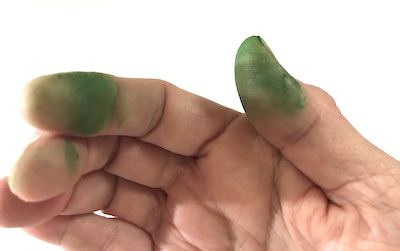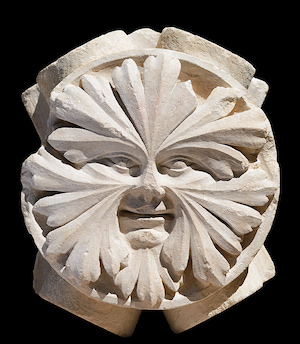Do You Have a Green Thumb or Green Fingers?
By Mary Farkosh-Francis, Fairfax Master Gardener Intern
 A person who has a green thumb is understood to have a natural talent for gardening, whether it is growing flowers, vegetables, grain crops or trees. Have you ever wondered where the expression “having a green thumb” originated? There are a surprising number of theories.
A person who has a green thumb is understood to have a natural talent for gardening, whether it is growing flowers, vegetables, grain crops or trees. Have you ever wondered where the expression “having a green thumb” originated? There are a surprising number of theories.
Some believe there is a link between the ancient pagan legend of the Green Man and the term green thumb. The Green Man motif appears in many cultures over many ages as a symbol of rebirth and the growth of plants that reappear each spring. The Green Man is often depicted with a face from which vines or other vegetation sprout.

The Green Man
Folk lore states that gardeners acquire a “green thumb” by pinching leaves and stems between their thumb and forefinger, staining especially the thumb. Another tale declares that gardeners without ready access to water are unable to clean their hands after working the soil and thus develop a fungus under the nails of their hand, in particular the thumb.
One of the oldest literary stories, albeit improbable, is associated with Geoffrey Chaucer’s The Canterbury Tales (circa 1396). Chaucer wrote that the Miller “hadde a thombe of gold,” which scholars believe is a reference to his grain-colored thumb or his heavy touch in weighing the flour. Hence a “green thumb” is seen as an analogy to the Miller’s “golden thumb.”

King Edward I
Probably the first literary mention of the term was in the 1906 novel called The Misses Make Believe. Scottish writer Mary Stuart Boyd wrote: “What old wives call green fingers: those magic digits that appear to ensure the growth of every plant.”
The expression “to have green fingers” was certainly popularized by C.H. Middleton, the host of the BBC radio program “In Your Garden” which aired in the 1930’s and 1940’s. He is also sometimes credited with popularizing the expression “to have a green thumb.”
According to James Underwood Crockett, famous for his appearance in the television series “The Victory Garden,” algae growing on the outside of earthenware pots stains a person’s thumb if one handles enough pots.
Early newspaper appearances of the term “green thumb” appear in the June 1937 edition of the Washington Post and the July 1937 issue of the Ironwood Michigan Daily Globe. In 1943, the novel Congo Song by Stuart Cloete states: “Some men have green fingers. Plants like them. They can make things grow because they love them.”
Some people fancifully believe that one inherits a gene for a green thumb from one or both parents, and that those who have genes from both parents are especially lucky.
No matter how these phrases originated, one thing is certain. It is wonderful to have a green thumb or green fingers!
Resources
Garden Quotes, Quote Authors.com
Green Thumb, The Word Detective
The Old Farmer’s Almanac
Green thumb and green fingers, The Grammarist
Green thumbs and green fingers, Grammarphobia